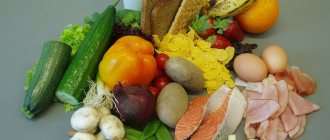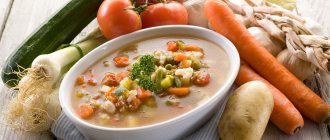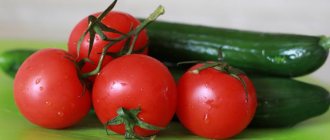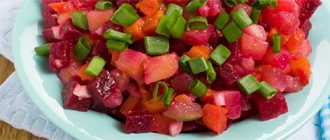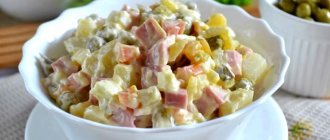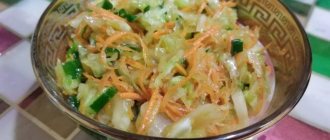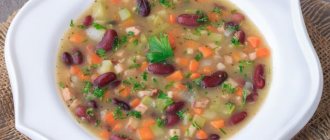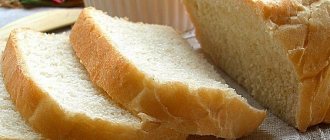“In Rus' without potatoes is like a party without an accordion”, “Potatoes are the second bread” - these are sayings from the past, but even today our people do not betray their favorite product. Potatoes contain many useful substances, but constant consumption of them leads to weight gain and, as a result, serious diseases. However, there are natural products that resemble potatoes in taste and cooking method, which also bring great benefits to the body.
How can you replace potatoes during a diet - read on.
Beans
For example, the familiar beans, available in any store and growing well in the middle zone. Why not? Its large bean seeds contain:
- abundance of dietary fiber;
- up to 60% carbohydrates (starch and other sugars);
- up to 30% valuable vegetable protein (it is close in composition to meat proteins and is absorbed by the human body by 75%);
- microelements (potassium, phosphorus, copper, zinc, etc.);
- vitamins (carotene, etc.).
In the diet of many southern peoples, beans occupy an important place, and our housewives widely use them to prepare various dishes. Beans can be stewed, boiled, canned, they have proven themselves excellent both as a separate side dish and as a component of soups, salads, casseroles, stews, and pie fillings.
Moreover, thanks to the abundance of varieties and varieties of beans, you can choose them to suit your taste - some varieties, when cooked, retain their density and shape, remaining elastic, while others, soft and oily, “boil” almost into mush.
With a calorie content of about 123 kcal per 100 g, boiled beans are considered a dietary product (for comparison, the calorie content of boiled potatoes is about 85 kcal per 100 g). Just like potatoes, beans are suitable for feeding people with gastrointestinal problems, for example, low stomach acidity.
- 5 incredibly delicious white bean dishes
What unusual and tasty things can you make from white beans? Find out from our article.
Swap spaghetti for vegetable pasta
Replacing pasta with false vegetable pasta forces us to consume vitamins and proteins instead of carbohydrates. There are special graters that cut vegetables into spaghetti shapes. Choose a vegetable (you can do this with carrots, zucchini, eggplant) and let it cook for a short time (the vegetable should not be too soft), then grate and season. You can add shrimp, tomatoes or chicken to this pasta - basically what you usually add to pasta.
Challenging puzzles with a Christmas theme: a mental exercise for the holidays
Delicious and aromatic DIY cookies with cinnamon, orange and chocolate
How to make perfect popcorn at home in a frying pan: recipe
Turnips and turnips
This unpretentious garden crop in Rus' was used for food long before potatoes appeared in the garden beds (remember the expression “easier than steamed turnips”?), but today it is practically forgotten by many in favor of “second bread”. And quite undeservedly. Let's explain why.
Turnips are not nearly as starchy (and therefore not as high in calories) as potatoes - about 30 kcal per 100 g.
Turnips contain beta-carotene, vitamins A, C, PP, B1, B2, E, fiber, vegetable protein, a lot of calcium and succinic acid (a universal biostimulant). Turnip helps fight hypovitaminosis, stimulates the secretion of gastric juice, enhances intestinal motility, and improves food absorption. The juice of fresh root vegetables is also used for medicinal purposes - as a remedy with diuretic, antiseptic, anti-inflammatory, wound healing and analgesic effects.
Elongated fodder varieties of turnips are called turnips, and they are also widely used not only for livestock feed, but also in “human” cooking.
What about the taste of turnip? In boiled (steamed) form, it is indeed very similar to unleavened potatoes - if you remove the excess starch from the latter and add a subtle flavor. Spices, honey, mustard or herbs will make boiled turnips a savory snack, and butter or sour cream will make a delicious side dish. Pieces of boiled turnips will also fit in any soup and salad, and gourmets can fry them in butter. Since root vegetables contain enough essential oils, their consumption in raw form should be limited in case of inflammatory diseases of the gastrointestinal tract.
Swap fries for baked ones
Potatoes are one of the foods that many people love most, especially when fried. If we want to continue to enjoy potatoes without worrying about extra calories and fat, we must cook them in the oven. Remember that potatoes must be natural, and pre-cooked potatoes are unlikely to be that way.
To prepare it, follow the steps:
- Cut the potatoes into equal sized pieces and leave in hot water for 30 minutes.
- Preheat the oven to 220°C.
- Drain and dry the potatoes with paper towels.
- Once dry, place it in a bowl and add salt and pepper to taste, stirring well to infuse all the pieces with flavor.
- Grease the bottom of the pan with olive oil and add the potatoes. Cover the dish with foil and bake for five minutes. Then remove the foil and continue cooking until the potatoes are crispy.
Swede
If we already mentioned turnips, let’s not forget its “close relative” rutabaga, which has also long been revered in Rus' as a valuable food crop and was on the tables of both the nobility and ordinary peasants.
In terms of calorie content, this product is almost twice as “cheaper” than potatoes - only about 37 kcal per 100 g. Rutabaga contains enough dietary fiber, vegetable protein, vitamins (especially C, A and group B), potassium, calcium and phosphorus. It is useful for the functioning of the intestines and heart, cleanses blood vessels, and relieves swelling. Raw rutabaga is also rich in mustard oil, which gives the root vegetable bactericidal properties, allowing its juice to be used as a medicine for colds, dry coughs, inflammations and burns.
Rutabaga is contraindicated in acute diseases of the gastrointestinal tract.
As for the taste, when boiled, stewed or baked, rutabaga really strongly resembles potatoes, allowing you to replace it in many dishes from stews and cutlets to salads and casseroles, and in its raw form, many compare it to juicy turnips (the main thing is not to let it overripe, become tough and fibrous). The root vegetable goes well with other vegetables and can act as a complete independent nutritious side dish for meat and fish.
Fruit water instead of soda
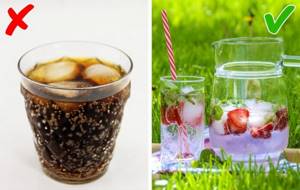
Soft drinks contain too many calories and sugar. Plus, they're easier to eliminate from your diet than we think. If we replace them with water flavored with fruit juice, we can consume the required amount of liquid per day without forcing ourselves to choke on tasteless water. You choose the flavor depending on the fruit you like.
To prepare this drink, you need to cut the selected fruit into slices and pour hot water over them. You can also add herbs or spices and liquid sweetener. Let the mixture sit for twelve hours and then discard the fruit.
Pumpkin, zucchini, squash
Why are all these vegetables “together” on our list? Because both the long zucchini we are used to and the squash plates are all varieties of the common pumpkin, and their fleshy pumpkin fruits are very similar in quality. Moreover, among all these vegetables there are quite sweet types and varieties, as well as quite neutral, almost “potato” taste - suitable for soups and side dishes (usually they are distinguished by color - the more red and orange, the sweeter the pumpkin, while white and green varieties have a more neutral taste).
The calorie content of pumpkins, zucchini and squash ranges from 20 to 40 kcal per 100 g - this is still much less than that of potatoes.
The vitamin and mineral composition of these fruits is very rich and very balanced, which allows them to be used in dietary nutrition. There is an abundance of fiber and vegetable protein, about 20% starch, vitamins (A, C, D, E, F, PP, T, group B), potassium salts, calcium, magnesium, iron, pectin, useful microelements (copper, cobalt, zinc, etc.).
Zucchini is the first vegetable that is introduced into baby food for babies, because... it practically does not cause allergic reactions.
All these vegetables are perfectly absorbed by the body and even help digest other foods. They can be added to children's menus, to the diet of people suffering from digestive and cardiovascular problems or those recovering from an illness, and used in various diets for weight loss.
The big advantage of pumpkins and zucchini is their ease of growing and long shelf life.
- Simple recipes for delicious pumpkin dishes
After looking through our selection of recipes, you will definitely want to cook pumpkin! The recipes are very simple!
- What can you cook from squash quickly and tasty?
Find out what dishes can be prepared from squash and what products are best combined with them.
- What to cook with zucchini - 15 simple recipes for every day
Simple recipes for incredibly delicious dishes made from fresh zucchini.
Table of alternatives to harmful foods with proper nutrition
There are many options for replacing this or that product in the diet, which for some reason does not fit into the diet or PN system.
| Harmful products | Cause | Useful alternative |
| Sausages, frankfurters, wieners | Calorie content, harmful additives, a lot of salt | Beef, chicken, rabbit |
| Pork | Calorie content, high fat content | Beef, chicken |
| Salmon, salmon | Calorie content, high fat content | Cod, carp, pike, pike perch, tuna |
| Chicken eggs | High cholesterol content | Quail eggs, chicken (fillet), avocado, fish |
| Green apples | Sharply increase acidity in the stomach, allergic | Pears, nectarines |
| Bananas | Calorie content and high GI | Pears, apricots, peaches |
| Grape | Calorie content and high GI | Melon |
| Avocado | Calorie content | Pumpkin |
| Mango | High GI | Melon |
| Persimmon | Calorie content and high GI | Apricots |
| Potato | Calorie content, starch content | Beans, buckwheat, cabbage (kohlrabi, cauliflower) |
| Mayonnaise | Calorie content, high fat content | Low-fat sour cream, natural yogurt |
| Cottage cheese 5 and 9% | High fat content | Cottage cheese 1%, sour cream (up to 10%) |
| Cheese | High fat content | Cottage cheese, tofu |
| Butter | Calorie content, high animal fat content | Olive, sesame, flaxseed vegetable oil |
| Bakery | High calorie content | Fruits, lean baked goods without sugar, eggs and wheat flour |
| Yeast bread | Presence of yeast, calorie content | Diet bread without wheat flour |
| Cookie | High calorie content | Dried fruits |
| Candy and chocolate | High calorie, high sugar content | Natural marshmallows and marmalade, honey |
| Chips and snacks | Calorie content, presence of harmful additives, trans fats | Dried fruits, vegetable chips, diet bread |
| Ice cream | Calorie content | Fruit and berry sorbet (no sugar) |
| Fruit juices | Minimal plant fibers, lots of sugars | Vegetable juices, fruits |
| Coffee | Slows metabolism, depresses the nervous system | Green tea, natural juices |
| Pickled vegetables | Contains a lot of salt, stimulates appetite | Pickled products (cabbage), fresh vegetables |
| Jams, jams, confitures | Lots of sugar and carbohydrates | Fruit and berry purees without sugar, fresh fruits and berries |
| Popcorn | Calorie content, high fat content | Vegetable and fruit chips |
For all unhealthy treats, if desired, you can choose a healthier and no less tasty alternative. This will allow you to diversify your diet without compromising your figure.
How can you replace potatoes in soup, Olivier salad, vinaigrette and other dishes when on a diet?
There are natural products that are close to potatoes in taste and types of dishes that can be prepared from them.
Celery
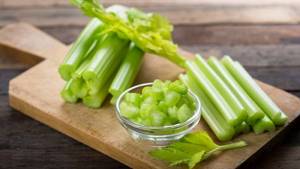
They eat stems, roots and leaves.
Calorie content is 6 times less than that of potatoes; 8 times less carbohydrates, and 4 times less fat, but contains the same amount of fiber. Protein per 100 g of product is only 0.9 g. Glycemic index – 15.
Celery is rich in vitamins:
- A (83% of the daily value in 100 g) improves vision and skin, supports the immune system, and is responsible for reproductive function;
- C (43%) strengthens the immune system, promotes the absorption of iron, and participates in redox reactions.
In addition, celery is high in sodium, which has a beneficial effect on the functioning of the kidneys and bladder. The plant has a diuretic effect.
Attention! Contraindications to eating celery in large quantities are urolithiasis and thrombophlebitis.
Celery tubers are fried like potatoes in a small amount of olive oil with chopped onions and added to the soup. Salads are prepared from the stems and leaves.
Low calorie content and low carbohydrate content serve as the basis for the use of this vegetable in dietary nutrition for weight loss.
Daikon, or Japanese (Chinese) radish
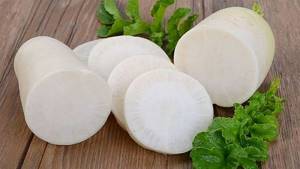
Root vegetable, subspecies of radish.
Calorie content is 3 times less than that of potatoes; contains less carbohydrates - 8 times, proteins - 2 times, fats - 2 times. Dietary fiber – the same amount. GI – 15.
Most of the root vegetables contain:
- vitamin C – 22% of the daily requirement;
- copper – 12% (it is involved in the processes of protein absorption and saturation of cells with oxygen).
Daikon tastes like radish or radish, but without the bitterness. It is used mainly raw in salads.
Due to its low carbohydrate content and low calorie content, it is used in dietary nutrition.
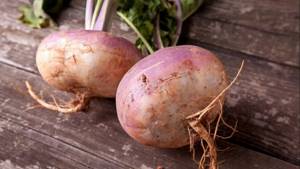
Calorie content – only 37 kcal. Glycemic index – 99. 100 g of product contains:
- proteins – 1.2 g;
- fats – 0.1 g:
- carbohydrates – 7.7 g;
- dietary fiber – 2.1 g.
It has a high content of vitamin C (33%), which is not destroyed during winter storage and cooking.
Rutabagas can be boiled, fried, or stewed. But it’s better to add it to other vegetables in the stew. Salads are made from the tops. In late winter and early spring, it continues to supply the body with vitamins, unlike other vegetables.
High GI does not allow the use of rutabaga as a product for weight loss.
Turnip
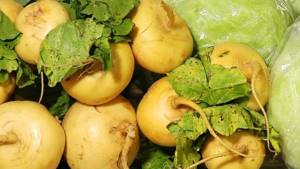
Calorie content and nutritional value are similar to rutabaga. The glycemic index is 15 for raw and 85 for cooked.
Turnips are useful:
- vitamin C – 22% of the daily value per 100 g of product;
- silicon – 303% (stimulates collagen synthesis);
- cobalt – 20% (part of vitamin B12, activates enzymes of fatty acid metabolism).
The root vegetable is used in salads, hot meat dishes, and soups. Turnips are fried, pickled, baked. This is a good dietary product.
Kohlrabi

A variety of white cabbage. But unlike it, it is not the leaves that are used for food, but the lower spherical part of the stem - the stem fruit.
Calorie content – 42 kcal. Glycemic index – 15.
100 g of product contains:
- proteins – 2.8 g;
- fats – 0.0 g;
- carbohydrates – 10.7 g;
- dietary fiber – 1.7.
Kohlrabi is a champion in vitamin C content - 56% of the daily dose per 100 g of product. “Northern lemon” is another name for this vegetable.
Cabbage contains a lot of potassium (15%) and silicon (237%).
Vegetables are stewed, fried, boiled, pickled, and prepared into salads.
Kohlrabi is considered a valuable dietary product due to its low fat and carbohydrate content and low GI.
Jerusalem artichoke, or earthen pear
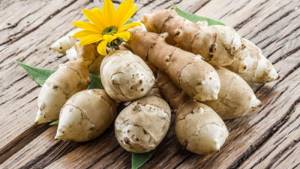
Another analogue. Its composition is similar to potatoes, but contains three times more fiber. Glycemic index – 14.
Jerusalem artichoke is rich in silicon - 26% of the daily dose per 100 g of product.
More than other vegetables, it contains the probiotic inulin (from 16 to 18%), which serves as a medium for lactobacilli and bifidobacteria and helps the body get rid of cholesterol.
It tastes like cabbage stalks. It is boiled, baked, stewed, eaten raw in salads.
Jerusalem artichoke should be limited to people suffering from flatulence.
Calorie content – 35 kcal. The glycemic index is 35 for raw and 85 for cooked.
100 g of product contains:
- proteins – 1.3 g;
- fats – 0.1 g;
- carbohydrates – 6.9 g;
- dietary fiber –2.4 g.
Carrots are rich in vitamins. For example, it contains 11% of the daily dose of vitamin K, which regulates blood clotting.
Important! 100 g of root vegetables contain double the daily requirement of beta-carotene. In the body, it turns into vitamin A, which improves vision and skin, supports the immune system, and is responsible for reproductive function.
Salads and casseroles are made from carrots, they are boiled, stewed, and pickled.
Low GI raw carrots are considered a suitable dietary food.
Yam or sweet potato
Its chemical composition is similar to potatoes. The glycemic index is 44 for boiled in the peel and 90 for peeled and baked.
Sweet potatoes are useful in vitamins:
- A – 33.3% of the daily value per 100 g of product;
- B5 – 16% (participates in protein and fat metabolism, hemoglobin synthesis);
- C – 25.6%.
The tuber contains many microelements:
- potassium – 15.9%;
- manganese – 12.9%;
- copper – 15.1%.
The peculiarity of sweet potatoes is a sufficient amount of valuable antioxidants (carotenoids, anthocyanins and phenolic acids).
Cooked sweet potato tastes like pumpkin, but raw sweet potato is similar to carrots in both color and taste. Can stay fresh for a long time thanks to protein. It is included in soups, side dishes and casseroles are made from it.
Sweet potatoes are a worthy substitute for regular potatoes when prepared correctly. Contains low GI carbohydrates, which promotes rapid satiety and reduced appetite. Insoluble fiber cleanses the intestines.
It is similar in calories, protein and fat content to potatoes. Contains four times less carbohydrates. Glycemic index – 15.
Cauliflower is beneficial for the vitamins it contains:
- C – 80% of the daily value in 100 g;
- K – 13% (regulates blood clotting);
- B6 – 10%.
Better digestible than white cabbage. Fiber practically does not irritate the walls of the stomach and cleanses the intestines well.
Cauliflower is a popular and tasty dietary product. It is boiled, fried, baked.
Legumes
The main representative is beans.
Calorie content – 297 kcal. 100 g of product contains:
- proteins – 21.0 g;
- fats – 2.0 g;
- carbohydrates – 47 g;
- dietary fiber – 12.4 g.
The glycemic index of white beans is 35, red beans are 27, and green beans are 15.
Attention! Fiber in 100 g of beans is 60% of the daily value.
Beans contain a lot of:
- vitamin B1 – 33.3% of the norm;
- B5 – 45%;
- B6 – 45%;
- B9–23%;
- RR – 32%.
Microelements:
- potassium – 44%;
- manganese – 67%;
- phosphorus – 60%;
- iron – 32.6%;
- selenium – 45%.
In taste and appearance of dishes, beans are close to potatoes, and in their nutritional value they are in many ways superior to them.
Beans are an ideal replacement for potatoes. It is put in soups, salads, and served as a side dish.
Other legumes (soybeans, peas, lentils) do not have such universal uses as potatoes or beans, although they are also used in various dishes.
Potatoes boiled in their skins, due to their low calorie content, average GI and the presence of plant fibers, are considered a good dietary product. However, when cooked in other ways, it loses its beneficial properties.
Other vegetables with their own set of useful nutrients may well become a substitute for potatoes during a diet - celery, daikon, rutabaga, turnips, kohlrabi, Jerusalem artichoke, carrots, sweet potatoes, cauliflower, legumes. A variety of foods will only benefit the body.
On a diet, with diabetes, with allergies, it suddenly turns out that your favorite potato is prohibited? Now what to cook as a side dish or put in all kinds of soups and salads? It turns out that a whole range of products can almost fully serve as potato substitutes – if you “agree” with their taste and texture.
What are potatoes in cooking? A high-calorie starchy substance rich in nitrogenous substances (complete plant protein), potassium, phosphorus, iron, vitamins C, A and B. Thanks to its “calm” almost neutral taste, potatoes are combined with many foods and spices and are included in hundreds of delicious dishes.
You can replace potatoes in your diet with vegetables with similar properties. Such replacements will be especially relevant for the body if these products are consumed boiled or baked instead of French fries or fried in oil. But which vegetables are equivalent to potatoes?
